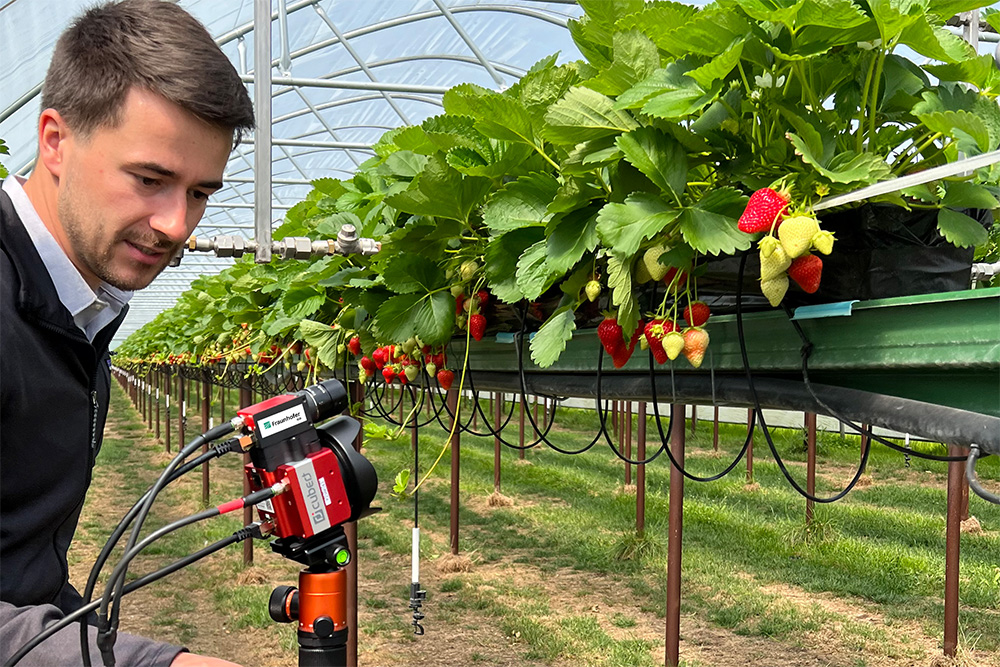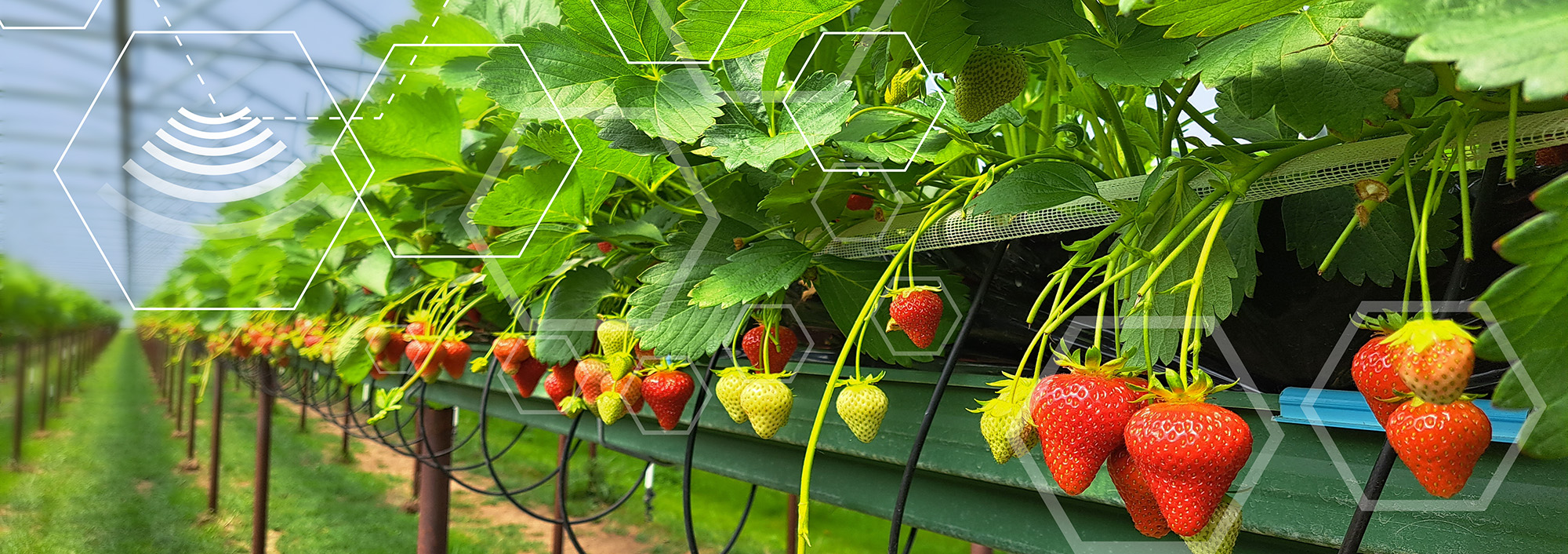Smart Farming technologies from Rostock
Fraunhofer develops automated processes and digital solutions for the future of strawberry cultivation
A number of Fraunhofer institutes have come together in the Biogenic Value Creation and Smart Farming initiative to develop digital systems and technologies such as planting robots, automatic pest detection and real-time frost warnings that are now being pioneered in strawberry cultivation.

Fruit farming and horticulture are important elements of the rural economy. However, because of the increasing constraints imposed by environmental protection, the food standards authorities and the drive for sustainable production, farmers are facing ever greater challenges due to limited availability of agricultural land, diminishing fossil resources and, above all, a shortage of skilled workers. Fraunhofer aims to meet these challenges by developing smart farming technologies. The “smart” element here refers to the application of digital solutions and automated processes in agriculture, for example using sensors or autonomous vehicles. Karls is one of the largest fruit growers in the German federal state of Mecklenburg-Vorpommern and an important employer in the region. The Fraunhofer Institute for Computer Graphics Research IGD and the Fraunhofer Institute for Large Structures in Production Engineering IGP are working with Karls to develop various smart farming technologies aimed at securing the viability of strawberry cultivation in the region. Prototypes are already being deployed in this year’s strawberry season. “At Fraunhofer, our research is practice-oriented,” explains Dr. Philipp Wree, department head at Fraunhofer IGD. “By this, we mean always geared to the very specific needs of those who will later be implementing the technologies we develop. What we find important is the very specific input of our partners in the field and the challenge of meaningfully transferring our scientific findings into practice.” The technologies developed and tested in strawberry planting can also be applied profitably in other fruit-growing and horticultural businesses as well as other agricultural sectors.
Smart technology for strawberries: Planting frozen seedlings outdoors
The transfer of frozen seedlings and their root balls for planting outdoors has so far been a purely manual task: the farm laborer digs a hole, inserts the young plant and then presses down the soil. This season, a first prototype supplied by Fraunhofer IGP has already helped to populate a complete polytunnel with seedlings. Planting boxes filled with substrate were transported on the underside of the work station, and eight drilling jigs dug out the holes. The seedlings still had to be inserted by hand, but the special shape of the drills eliminated the need to press the soil down manually. Even at this early stage of development, it proved possible to reduce planting time by half. The enormous time savings are not the only benefit of the automated process; quality is also enhanced by the identical spacing between the plants, the uniform depths and the uniform substrate density. In the future, the planting robot will take over all the work steps that would otherwise have to be done by hand when planting strawberry seedlings in racks.
After the seedlings have been planted in the polytunnel, they must be continuously checked for pests or diseases. The measuring technology of Fraunhofer IGP and the expertise in visual computing of Fraunhofer IGD come in handy here. AI-based software inspects images taken by special multispectral and hyperspectral cameras and detects the first symptoms of fungal diseases such as phytophthora and mealybug or damage caused by caterpillars, even before they become visible to the human eye. Infected plants can then be treated before the disease spreads over a wide area.
When strawberries are planted outdoors, they are exposed to often unfavorable weather conditions. The larger the cultivated area, the more difficult it is for farm operators to monitor and to introduce localized measures such as irrigation or fertilization. Fraunhofer IGD is currently working in collaboration with the start-up Agvolution on the Karls estate to test a large-scale sensor network for recording soil and air parameters based on Mioty® radio technology. Mioty® was originally developed by the Fraunhofer Institute for Integrated Circuits IIS for use in industrial infrastructures. It allows data transmission over several kilometers with very low energy consumption. In agriculture, it can thus be used to record the microclimate over a wide area. A typical application scenario utilizing this technology would be to deliver frost warnings in real time.
“The collaboration between Karls and the Fraunhofer Institutes IGD and IGP is literally bearing fruit,” says Thomas Hahmann, project manager at Karls Erdbeerhof. “The outstanding features that characterize this partnership are the spirit of innovation, the flexible approach and the speed with which new ideas and solutions are implemented. The judicious linking of theory and practice are particularly noteworthy here.”
Concentrated expertise: Networking at regional and national level
The research teams work closely with farmers in Mecklenburg-Vorpommern, whose ideas and feedback provide valuable input for further developments. Fraunhofer is part of a very strong infrastructure in the field of agricultural research. This includes the Faculty of Agricultural Sciences at the University of Rostock, the University of Greifswald (heavily involved in peatlands and peatland protection), the Research Institute for Farm Animal Biology in Dummerstorf, the experimental farms in Tellow and Dummerstorf, the Julius Kühn Institute for Cultivated Plants, the universities of Neubrandenburg and Stralsund, and the state-run experimental stations. Fraunhofer has strong links with all of the above players and endeavors to translate the scientific findings in combination with requests and feedback from practice into useful solutions.
The two Rostock institutes – Fraunhofer IGP and Fraunhofer IGD – are constituent parts of the overarching Fraunhofer Initiative for Biogenic Value Creation and Smart Farming. In association with three Fraunhofer institutes in Bavaria, the research teams are working on application-oriented research in all areas of food and agriculture, including plant cultivation, animal husbandry and the use of moorland. The interdisciplinary teams contribute comprehensive expertise from the fields of robotics and automation, sensors, analytics and actuators, AI and Big Data, as well as design, production and process engineering. The aim of the initiative is to develop new technologies for the sustainable production and processing of agricultural products – from seed to the supermarket shelf. With the development of highly individualized, automated and sustainable technologies, the initiative is contributing to the long-term security and viability of regional agriculture and food production. The initiative is being jointly funded by the German Federal Ministry of Education and Research to the tune of 40 million euros, with 20 million euros each coming from the science ministries of the German states of Mecklenburg-Vorpommern and Bavaria.
 Fraunhofer Institute for Computer Graphics Research IGD
Fraunhofer Institute for Computer Graphics Research IGD